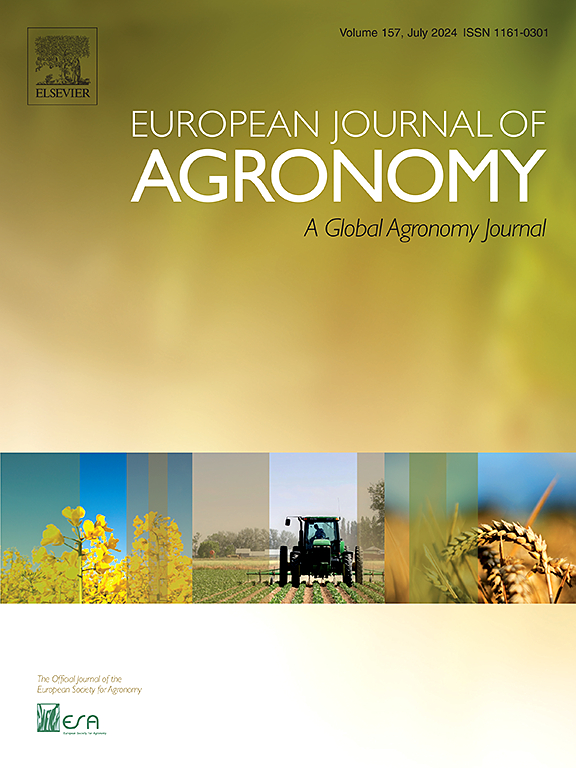Combining modelling and experiment to quantify light interception and inter row variability on intercropped soybean in strip intercropping
IF 4.5
1区 农林科学
Q1 AGRONOMY
引用次数: 0
Abstract
Taller crops affect the direct light interception and use efficiency of shorter crops in strip intercropping. Quantifying the light interception of shorter crops and optimizing it by manipulating the configurations could reduce lodging and produce a greater yield. Prior investigations have examined the instantaneous light interception of short-stature crops in intercropping. However, the direct quantification of daily light interception (DAI) and its inter-row variation in strip intercropping remains unclear. In this study, we developed a modelling approach to quantify the daily light interception of soybean plants in different arrangements of maize soybean strip intercropping and verified its accuracy by measuring photosynthetic active radiation (PAR) and phenotypic response (plant height, leaf area, biomass, and yield) to light. Treatments included five intercropping systems (1M1S represents one maize row intercropped with one soybean row, 2M1S, 2M2S, 2M3S and 2M4S represent two maize rows intercropped with 1–4 soybean rows, respectively, with the increase of soybean strip width) and two sole soybean cropping system (S40 and S50, soybean row distances of 0.4 m and 0.5 m, respectively), all plants were planted in east-west rows direction. Our results showed that the DAI calculated using the new model of the soybean canopy in intercropping was lower than that in sole cropping. At the grain-filling stage, the DAI at the soybean canopy increased from 29.3 MJ/m2 in 1M1S to 125.6 MJ/m2 in 2M4S. In 2M2S, 2M3S, and 2M4S, the DAI of border rows (soybean rows close to the neighboring maize row) on the north side were 1.37, 8.89, and 18.72 times higher than those of the border rows on the south side, respectively. DAI was significantly correlated with the measured instantaneous PAR and increased with an increase in soybean strip width. The measured plant height, leaf area, biomass, and grain yield of soybean across each row of each intercropping treatment exhibited a consistent trend with changes in DAI, and they were positively correlated with the soybean strip width. Soybean plants in rows with less light interception showed an obvious shade response: plant height increased, and leaf area, biomass, and yield decreased. This physiological response of soybean was caused by changes in light interception, confirming the accuracy of the model. The proposed light interception model and related physiological responses offer a quantitative approach and reference for understanding light competition in strip intercropping systems to design better strip configurations.
采用模拟与试验相结合的方法,定量研究了带状间作大豆的截光和行间变异
条播中高作物影响矮作物的直接截光和利用效率。量化矮秆作物的截光量,并通过控制构型对其进行优化,可以减少倒伏,提高产量。先前的研究对间作中矮小作物的瞬时光截留进行了研究。然而,对带状间作日光截留量及其行间变化的直接量化尚不清楚。在本研究中,我们建立了一种建模方法来量化玉米大豆条带间作不同安排下大豆植株的日截光量,并通过测量光合有效辐射(PAR)和表型响应(株高、叶面积、生物量和产量)来验证其准确性。5个间作制度(1M1S为1行玉米间作1行大豆,2M1S、2M2S、2M3S和2M4S为2行玉米间作1-4行大豆,大豆条宽增加)和2个单作制度(S40和S50,大豆行距分别为0.4 m和0.5 m),所有植株均沿东西行方向种植。结果表明,套作时大豆冠层的DAI低于单作时的DAI。灌浆期大豆冠层DAI由1M1S的29.3 MJ/m2增加到2M4S的125.6 MJ/m2。在2M2S、2M3S和2M4S中,北侧边行(紧邻玉米行的大豆行)的DAI分别是南侧边行的1.37倍、8.89倍和18.72倍。DAI与瞬时PAR值呈极显著相关,且随大豆条宽的增加而增加。各间作处理每行大豆的株高、叶面积、生物量和籽粒产量与DAI变化趋势一致,且与大豆条宽呈正相关。遮光较少行内的大豆植株表现出明显的遮荫反应:株高增加,叶面积、生物量和产量下降。大豆的这种生理反应是由光拦截的变化引起的,证实了模型的准确性。本文提出的光拦截模型和相关生理反应为了解带状间作系统的光竞争提供了定量方法和参考,从而设计更好的带状间作结构。
本文章由计算机程序翻译,如有差异,请以英文原文为准。
求助全文
约1分钟内获得全文
求助全文
来源期刊

European Journal of Agronomy
农林科学-农艺学
CiteScore
8.30
自引率
7.70%
发文量
187
审稿时长
4.5 months
期刊介绍:
The European Journal of Agronomy, the official journal of the European Society for Agronomy, publishes original research papers reporting experimental and theoretical contributions to field-based agronomy and crop science. The journal will consider research at the field level for agricultural, horticultural and tree crops, that uses comprehensive and explanatory approaches. The EJA covers the following topics:
crop physiology
crop production and management including irrigation, fertilization and soil management
agroclimatology and modelling
plant-soil relationships
crop quality and post-harvest physiology
farming and cropping systems
agroecosystems and the environment
crop-weed interactions and management
organic farming
horticultural crops
papers from the European Society for Agronomy bi-annual meetings
In determining the suitability of submitted articles for publication, particular scrutiny is placed on the degree of novelty and significance of the research and the extent to which it adds to existing knowledge in agronomy.
 求助内容:
求助内容: 应助结果提醒方式:
应助结果提醒方式:


